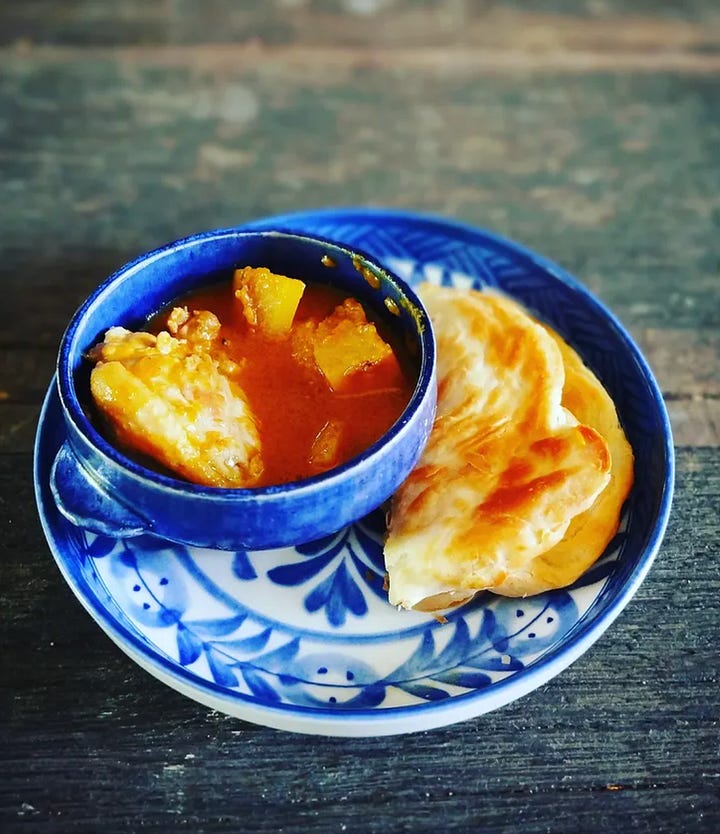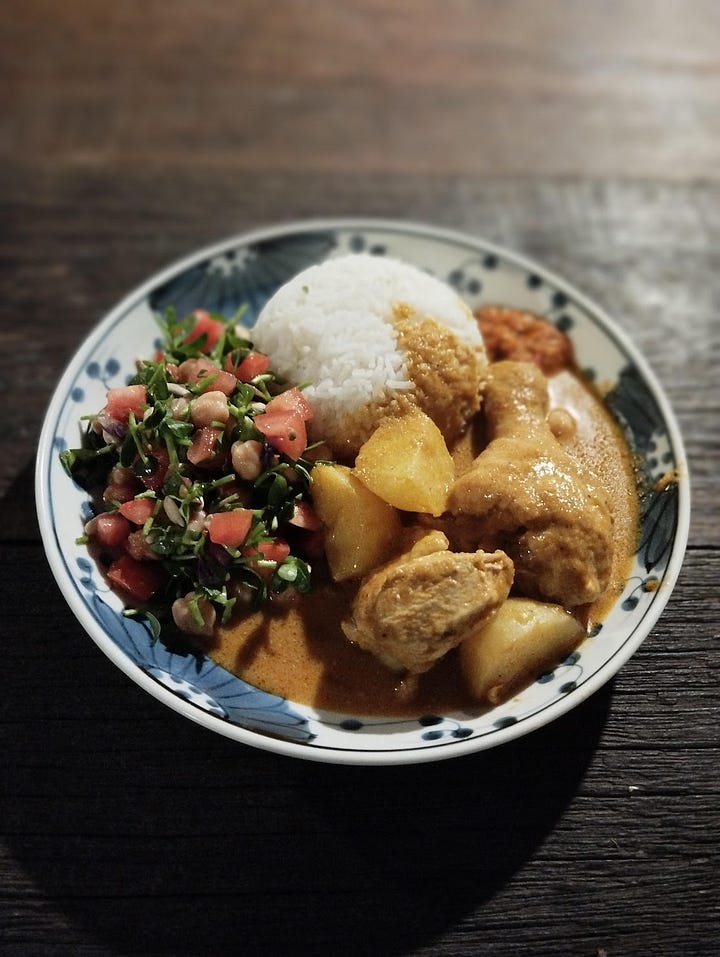

When I was at school in the UK in the late seventies, I remember vividly when the first Malaysian restaurant opened near Leicester Square at the tail end of the boom of Indian restaurants. After trying most of the dishes, the one I would keep returning to was the Roti with chicken curry. In Malaysia, this would be a dish available from Indian Muslim eateries and popular for breakfast. In this London, Chinese Malaysian owned restaurant was testament to the ubiquity of that curry which now featured on tables across almost all Malaysian communities. It was also relatively consistent in flavour with curry powder and coconut milk being its key ingredients.
In our Eurasian home I also knew of another chicken curry - a very mild one called Country Captain. In Lizzie Collingham’s book Curry A Tale of Cooks and Conguerors she describes this curry as “one of the best-known Anglo-Indian curries”, detailing a very simple recipe of chicken cooked with ground chillies and Turmeric.


Bridget White-Kumar’s “(Grandma’s) Country Captain Chicken” recipe expands it somewhat with the addition of cinnamon, cloves and cardamons. Both speculate that versions of this very popular colonial dish served at clubs and army messes was named as one served at the Captain’s table of Country River steamers plying between Bengal and Chittagong and other parts of Burma. 1
In his book The 'Fan Kwae' at Canton Before Treaty Days 1825-1844, William C Hunter - an American native of Kentucky residing in Guangdong, discusses eating the dish at the anchorage at Whampoa. The pathways of the India-China trade would bring Country Captain to Southern USA where it remains popular to this day, a version which now features chopped tomatoes and raisins as key ingredients - see image below left. It first appears in Miss Leslie's New Cookery Book an American cookbook from 1857 Eliza Leslie, closely resembling Collingwoods version - see image below right.


In Ellice Handy’s My Favourite Recipes, the first Malayan cookbook published in 1954, there are two recipes for Country Captain- the simpler one much like Collingwood’s and the one I had at home: mild and more like a yellow chicken stew. The second version is a spicier one, which, with the addition of coconut milk and Indian spices begins to emulate the ubiquitous Malaysian Chicken Curry that we now see served with roti, as a side with Nasi Lemak, or on home tables across all communities in Malaysia.
Most modern day renditions of this Chicken Curry bypass the preparation from scratch of its dry spices which include dried chillies, cloves, coriander seeds, cumin seeds, cinnamon sticks and star anise instead using spoonfuls of Curry powder blended from those same spices. It’s worth noting here that curry powder also distinguishes curries made in the Malay community called gulai which include more South East Asian ingredients like lemon grass, galangal and candlenut.
Lizzie Collingham, writes that curry was something “the Europeans imposed on India’s food culture lumping more nuanced dishes like rogan josh, dopiaza, and qorma altogether under the heading of ‘curry.’ Curry powder would become a British colonial invention that would travel the world and become an important trade item. In Scotland the advert on the right dates back to 1798. By the mid 1800’s in Britain the number of companies selling Indian curry powders and pastes in Britain had grown substantially.


The word '‘curry” “may have been adapted from kari in the Malayalam, Kannada, or Tamil languages — the last of which can translate to "a spiced sauce." In Portuguese, the plural of caril was carie or curree, which the British further evolved into curry”. The word itself remains controversial triggering conversations around appropriation, colonialism and authenticity as discussed here at length by Sejal Sukdhawala author of the Philosophy of Curry.
The video below explores the origins of Massaman curry a dish whose inclusion of Indian spices is in marked contrast to other typical curries or Gaeng in Thailand. Theories of how it came to Thailand span stories from Persian immigrants to an earlier Cambodian version attributed to Cham Muslims bringing it to India. What caught my eye however is how Southern Thais serve Massaman with Roti linking this to the Malaysian Chicken curry complicating the story even further by adding more branches to its’s South East Asian tree.
There are two more versions of Country Captain in Malaysia: the Kristang community’s version with limes or vinegar as a souring agent in Chicken Captain and the Chinese Peranakan community’s Kari Kapitan which additionally has Kaffir lime leaves. Both of these may be found within each community’s homes, cook books or restaurants, but the source code for Curry - a blend of Indian, East Indies spices, South American Chillies brought to Asia by the Portuguese ,can be found all around the world from the curried fillings of Jamaican patties to our own Kari Ayam and eastwards to the Japanese Kare Raisu.




